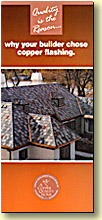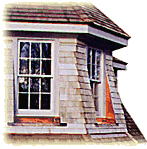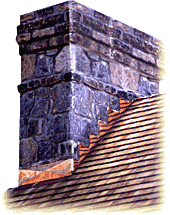 |
Your builder knows...
|
What is flashing?
Flashing is the waterproofing material installed under shingles or tiles where two roofs intersect. Flashing is also installed where the roof ends or abuts a wall. And you'll see flashing used around chimneys and vents that penetrate the roof.

Why is flashing important?
Flashing is your home's primary defense against water. Flashing keeps water from getting inside your home and causing costly damage. This is important because a leaking roof can cause rot damage so extensive it can compromise the structural integrity of your home.
Why copper flashing?
Copper flashing offers beauty, low maintenance and a long service life. As a bonus, copper flashing adds to the resale value of your home. And, unlike most other flashing materials, copper doesn't need to be replaced when you need a new roof.
 What is the normal life of a roof?
What is the normal life of a roof?
It depends on the roofing material you select. Shingles typically last 12-15 years. Architectural grade shingles can last 25-30 years, cedar shingles 30-40 years. You can expect 60-80 years with slate, tile or copper shingles.
What about the service life of copper flashing?
Regardless of where your home is being built, copper flashing provides long-lasting, reliable protection. For example, in coastal environments, copper naturally resists salt water corrosion, unlike aluminum and galvanized steel, which both corrode quickly.
Is copper flashing expensive?
Copper is about equal in cost to galvanized steel and is initially somewhat more expensive than other shorter-lived materials. Given the long life and reliable performance of copper flashing, it's worth it. Rest assured, no other flashing material can ensure and enhance the performance of your roof like copper.
Take a moment to find out more about the material used in such an important part of your new home - the roof. You'll see that quality is the reason your builder chose to install copper flashing.
